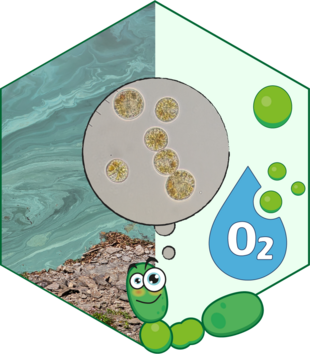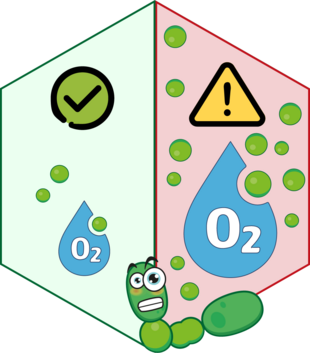We breathe thanks to them!
Cyanobacteria, commonly known as "blue-green algae," are not algae, but photosynthetic bacteria. They are naturally present in surface waters (rivers, lakes, ponds, etc.). Cyanobacteria are among the oldest known forms of life. They were responsible for enriching the atmosphere with oxygen nearly 2 billion years ago, making the emergence of aerobic life as we know it today possible.
So why should we be concerned by them... and why should we monitor them?
Most of the time, cyanobacteria do not pose a problem in aquatic resources because they are part of natural phytoplankton communities. However, under certain conditions, cyanobacteria can multiply rapidly and form greenish mats or streaks in the water called "blooms." This phenomenon generally occurs during summer and fall. Under such blooming conditions, cyanobacteria can produce high levels of toxins, including hepatotoxins, neurotoxins, and dermatotoxins. Exposure to these toxic metabolites therefore poses a potential risk to human and animal health.
High concentrations of cyanobacteria can also result in deoxygenation of the water column during their decay, thereby killing fishes and invertebrates, among others.
Why do cyanobacteria bloom here and not elsewhere? A fragile and complex balance
The development of cyanobacteria does not depend on a single factor, but on a complex combination of environmental, physical, and biological conditions.
Each ecosystem reacts differently, making blooms difficult to predict. To better understand their occurrence, it is essential to consider several interdependent factors:
Nutrient inputs
Cyanobacterial blooms are one of the consequences of eutrophication, i.e., an excessive accumulation of nutrients in the aquatic environment. These nutrients (nitrogen, phosphorus) originate from municipal wastewater discharges and agricultural practices and they can promote the development of cyanobacteria.
Meteorological conditions
The frequency and intensity of precipitation, wind speed and direction, and water residence time are all conditions that must also be considered. For example, precipitation can both increase nutrient inputs (and thus promote blooms) and create dilution in the water body (potentially limiting blooms). Wind, on the other hand, can disperse cyanobacteria accumulated along the shore and induce mixing of the water.
Intrinsic characteristics of cyanobacteria
The ability of cyanobacteria species to fix and store atmospheric nitrogen, their buoyancy, their growth rate, or their optimal temperature, influence both their proliferation in the ecosystem and the diversity of the species that predominate. Also, cyanobacteria species do not all necessarily produce toxins.
Seasonality
The massive development of cyanobacteria occurs more commonly in late summer (August-September), but weather conditions in the preceding months can greatly influence this dynamic. In addition, the presence of dormant cyanobacteria in sediments during winter may promote cyanobacteria recruitment in spring and amplify the bloom phenomenon in summer/fall.
Monitoring blooms: a complex but essential mission
A major challenge for researchers and managers is to monitor the proliferation of cyanotoxin-producing cyanobacteria.
The difficulty stems from the fact that their spatial and temporal distribution is highly dynamic and can change within hours. Bloom dynamics vary greatly on a daily, seasonal and yearly basis.
Some species can move vertically in the water column, or they are carried by wind or currents, some even form dense layers at intermediate depths in a water body.
Sampling methods must therefore be adapted to this variability to accurately assess the risk and enable site managers to take the necessary actions to protect water users.








